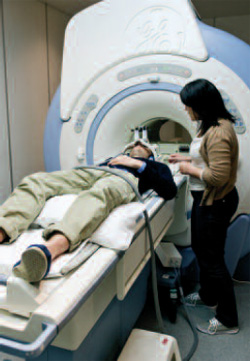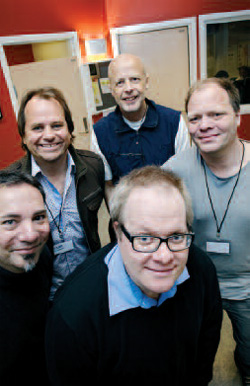Your brain reveals your choices
A neuroeconomic study is being conducted at Haukeland University Hospital, the first of its kind in Norway. Economists and neuroscientists have joined forces to study how the brain works when you make economic decisions. The goal is to show that we do not dislike inequality, but injustice. In Norwegian
13.03.2012 - Sigrid Folkestad
Doctors, psychologists and radiographers have joined researchers from the Norwegian School of Economics (NHH) to carry out a historic Norwegian research project. The research team wants to study what happens in the brain when people make economic choices and assessments. Neuroeconomics is an interdisciplinary field where economic theories about people's decision-making processes are linked to knowledge about the brain and cognitive processes, a field in which research has been conducted internationally, but not in Norway.
Do we dislike inequality? No, we don't, say the researchers
'Do you have any metal in your body? No? Good. A pacemaker? Any drain tubes in your head?' asks radiographer Turid Randa. She is doing the final check of the first test person, Andreas Bakkerud.
Bakkerud will soon finish his master's degree in finance at NHH. He is one of 40 NHH students who have volunteered for Norway's first neuroeconomic research project. He is being prepared for scanning in the MRI machine. The researchers will soon be able to access his brain activity with the help of a method used in international neuroeconomic studies: functional Magnetic Resonance Imaging, or fMRI. It allows researchers to see how different areas of the brain contribute to economic decision-making.
The point of departure of the experts in Bergen is fairly audacious. NHH researchers reacted when an American research group had an article published in the prestigious journal Nature. In Nature, the research group claimed that they had found neural evidence that people dislike inequality.
'We read the article "Neural evidence for inequality-averse social preferences" and felt that this was an issue we had to get to address and develop. We want to refute the interpretation put forward in this article and prove that people do not have an aversion against equality as such, but that they dislike injustice, and that we sometimes think that inequality is fair,' says Professor Alexander W Cappelen.
The research team from NHH that is behind the study consists of Professor Alexander Cappelen, Professor Bertil Tungodden and Associate Professor Erik Sørensen. Professor Kenneth Hugdahl, senior researcher Karsten Specht and medical doctor and Adjunct Professor Tom Eichele are participating from the University of Bergen (UiB) and the Faculty of Psychology. The researchers plan to launch their findings internationally.

Radiographer Turid Randa makes sure that Andreas Bakkerud is all right and tells him to lie completely still.
Foto: Siv Dolmen
Distribution choices and brain activity
Guinea pig Bakkerud is excited and curious. The radiographer gives him instructions and he tests the special glasses that he has to wear while being scanned. Through the glasses, he sees a computer screen with tasks that he has to solve. The tasks consist of choices where he must divide money between himself and others.
Prior to the scanning, the experimental subjects have carried out a real work task, which will be rewarded. Once they are in the MRI machine, they are faced with several choices based on what they think is a just distribution of the money. The choices are synchronised with their brain activity, and while they are considering how to distribute the money between themselves and others, the researchers measure the neurological activity in the areas of the brain that have been found to be involved in the assessment of monetary rewards. The brain's reward centre is sensitive, and the researchers can assess and interpret the connections on the basis of the choices made and the neurological activity.
Radiographers Turid Randa and Roger Barndon alternate between monitoring the screen showing screenshots of Bakkerud's brain and Bakkerud himself, who has to lie in the scanner for 40 minutes. Doctor Heike Eichele is sitting at another computer checking that the tasks are shown correctly and that answers are registered. Researchers Karsten Specht and Erik Sørensen keep an eye on the whole process.
The entire process is a collaboration, which Professor Cappelen also emphasises; it did not take long to initiate the collaboration between NHH and UiB. The pictures of the brain show red and orange spots, which indicates that the experimental subject is working on distribution. Because of protection of privacy considerations, we are not allowed to follow the subjects' choices or reproduce any images of the brain activity.
International attention
Professor and neuroscientist Kenneth Hugdahl also stops by the control room to see how things are going. He is head of the Bergen fMRI group, which the NHH researchers are cooperating with. This group is a National Research Centre for fMRI, which consists of an interdisciplinary research group at UiB and Haukeland University Hospital.
'This is a unique collaborative project in the Norwegian context. It is an exciting development for us neuroscientists when economists take more and more interest in this approach. I don't really know why this is, or whether biology and brain research have become more accepted in social sciences circles in recent years, but it is an interesting development for us as well,' says neuroscientist Kenneth Hugdahl.
'Why?'
'We usually live in an "artificial" world, and it is equally interesting for us as for the economists to try out some of our research methods on something that is of direct relevance to society.'
'Do you believe that you will find new, applicable findings?'
'Not only do I believe that there will be new findings and new results, I think this idea and the thinking of the NHH researchers could also enjoy a breakthrough internationally. It could attract attention internationally. This project is at the very cutting edge of research.'

Karsten Specht, Bertil Tungodden, Kenneth Hugdahl, Alexander Cappelen and Erik Sørensen make up the research group of economists and neuroscientists, in addition to Professor Tom Eichele.
Foto: Siv Dolmen
The article in Nature
The American researchers found neural evidence that people dislike inequality. The researchers in Bergen wanted to take these findings one step further, according to Professor Cappelen.
'This is a good example of how researchers build on each other's results. We argue against the interpretation of the findings that were presented in Nature, but that does not mean that they are not interesting or that they are incorrect. It is primarily the interpretation that these findings are evidence that people dislike inequality in general that we want to put to the test.'
The authors of the article had an exciting idea, Professor Cappelen believes, namely to use neurology to show that people dislike inequality in a specific situation, and that the joy of reducing inequality is not fundamentally different from the joy of receiving money oneself. This is important to economists, because it is conceivable that considerations of justice and inequality are affectations and that the basic driving force is self-interest and a desire to get as much money as possible for oneself.
The collaboration in Bergen is basic research, Professor Cappelen says. He believes it will provide better insight into how people make economic decisions. This will be particularly useful to economists, who have traditionally had a simplified idea of how people make decisions, he believes.
'The discipline of economics has traditionally been based on a stylised model that says that people are primarily motivated by self-interest. This is one of several contributions that can show that human motivation is more complex than previously assumed. This can increase our understanding of how people make decisions in markets and other situations.'
|

